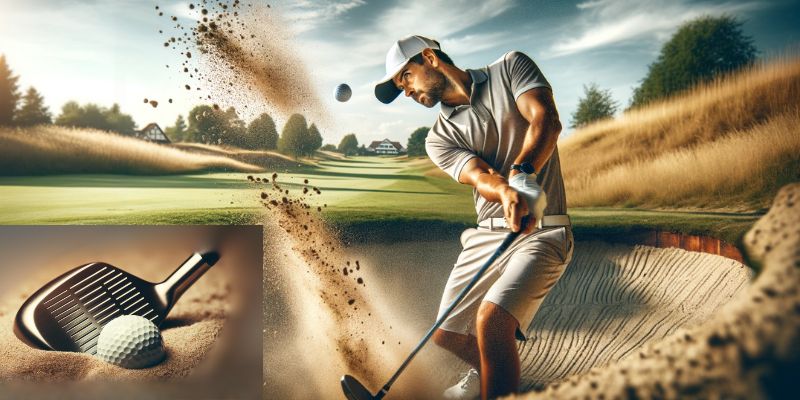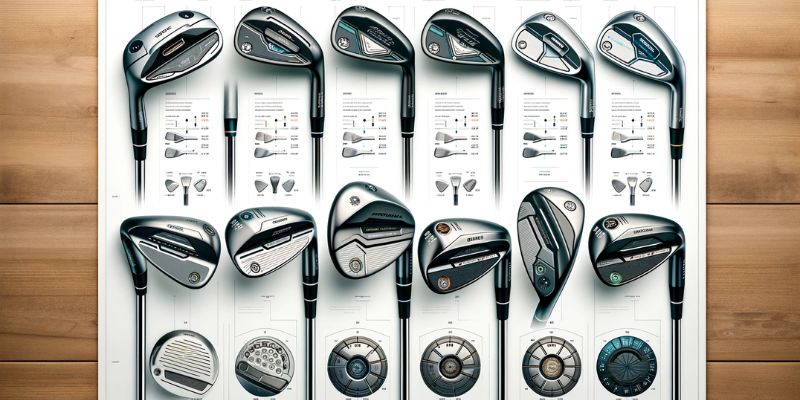
by Mark Preston | May 20, 2024 | Golf Equipment & Products - Reviews, Articles & Guides
For golf wedges for seniors, selecting the right equipment is crucial to maintaining performance and enjoyment in the game.
Golf wedges specifically designed for seniors can significantly enhance playability and comfort.
Understanding which golf wedges for seniors are best suited for your game can transform your experience on the course.
Features Beneficial to Seniors
When it comes to golf wedges for seniors, certain features stand out that can really make a difference.
Lightweight materials are a prime component, as they help reduce the overall weight of the club, making it easier to swing without excessive effort or strain on the body.
Graphite shafts are often recommended because they offer additional flex, which can help generate more speed and control despite slower swing speeds that often come with age.
Another critical feature is a larger grip.
As we age, our grip strength may diminish, making a bigger grip essential for better control and comfort.
Some wedges are also designed with larger heads and more forgiving sweet spots to accommodate less precise strikes, which can be beneficial for senior players.
Adjusting Your Game as You Age
As senior golfers continue to enjoy the game, adjusting your approach is necessary to align with changes in physical capabilities.
Golf wedges for seniors should promote easier shot-making with less physical demand.
For example, wedges with a higher loft and lower center of gravity can help get the golf ball airborne more easily, reducing the need for power and minimizing the risk of injury.
It’s also advantageous to focus on your short game, as precision with wedges can compensate for decreases in driving distance.
Utilizing wedges that offer better control and spin can help keep your scores competitive without the need for long-distance shots.
Top Picks for Seniors
When choosing golf wedges for seniors, consider options that combine forgiveness with functionality.
Brands like Callaway, Titleist, and Cleveland often design golf wedges and Hybrids with senior players in mind.
These wedges typically feature perimeter weighting for added forgiveness, innovative sole designs for smoother turf interaction, and varied bounce options to suit different playing styles and conditions.
- Callaway Mack Daddy Series: Known for their balance between forgiveness and control, these wedges are great for seniors who want to maintain accuracy around the greens.
- Cleveland CBX 2 Wedge: With a cavity back design, this wedge offers extra forgiveness and a sole that glides through the turf to help manage any lie easily.
- Titleist Vokey SM8: While slightly more advanced, the Vokey design provides exceptional spin control and a variety of loft and bounce combinations to suit any senior golfer’s needs.
Choosing the right golf wedges for seniors is about balancing performance with physical comfort and playability.
A well-chosen wedge can make a significant difference, making it a perfect gift to enhance enjoyment and effectiveness on the golf course.
Why are lighter materials recommended for senior golfers?
Lighter materials help reduce the overall strain during a swing, making it easier for seniors with diminished strength or flexibility to play comfortably.
How often should a senior golfer replace their wedges?
It depends on frequency of play, but generally, checking the grooves annually for wear and replacing them every few years is advised to maintain performance.
Can a custom fitting benefit senior golfers?
Absolutely. Custom fitting ensures the clubs are tailored to individual swing characteristics, which is crucial for maximizing performance and minimizing injury risks as one ages.

by Mark Preston | May 20, 2024 | Golf Equipment & Products - Reviews, Articles & Guides
Analyzing the Impact of Groove Wear on Wedge Performance
Groove wear on wedge performance significantly affects how golfers control and spin the ball.
Understanding this aspect can elevate your game by ensuring your equipment is in top condition.
Signs of Groove Wear
Identifying groove wear on wedge performance is crucial for maintaining effective play.
The first sign is a visible wear on the grooves themselves.
If the edges of the grooves in your wedge appear rounded or smoothed out instead of sharp and defined, it’s a sign that the grooves have worn down.
This wear can lead to a decrease in the wedge’s ability to impart spin on the ball, resulting in less control over your shots.
Another indicator is the performance of the ball upon impact and during flight.
A wedge with significant groove wear may cause the ball to react differently upon striking, showing less grip on the green, and a tendency to roll out more instead of stopping quickly.
Impact on Ball Spin and Control
The role of groove wear on wedge performance cannot be overstated when it comes to ball spin and control.
Fresh, sharp grooves are essential for creating more spin, especially in short games where precision is crucial.
The grooves act by channeling away materials like turf and moisture from the ball, allowing closer contact and thus more spin.
As grooves wear down, their ability to channel these materials efficiently diminishes, resulting in less friction and spin.
This reduction can affect not just the stopping power on the green but also the overall trajectory and peak height of your shots.
Golfers might find it increasingly difficult to manage pin positions and control green-side shots effectively.
Groove Maintenance Tips
Maintaining your wedges is key to minimizing groove wear on wedge performance. Here are some essential maintenance tips:
- Regular Cleaning: Always clean your wedge grooves after every round. Use a groove cleaner tool or a stiff brush to remove dirt, grass, and debris, which can compact in the grooves and lead to premature wear.
- Periodic Inspections: Regularly inspect your wedges for signs of wear. If the grooves start to show significant rounding or you notice a change in your ball spin and control, it may be time to consider having them re-grooved or replaced.
- Proper Storage: Store your wedges in a dry, cool environment to prevent any rust or additional wear. Moisture can be particularly detrimental to the longevity of the grooves.
Understanding and addressing groove wear on a golf wedge performance is essential for any golfer looking to maintain precision and control in their short game.
Regular maintenance and timely replacement of wedges can make a significant difference in performance, making each wedge in your bag a perfect gift to your golfing success.
How often should I check my wedges for groove wear?
It’s a good practice to check your wedges for wear every 15-20 rounds, or more frequently if you play in abrasive conditions such as sandy soil.
Can worn grooves be restored?
Yes, depending on the extent of wear, grooves can often be re-grooved or sharpened by a professional to restore performance.
Are there legal limits to groove depth and sharpness in tournaments?
Yes, the USGA has regulations regarding groove depth and sharpness to ensure fair play. It’s important to ensure any re-grooving complies with these rules.

by Mark Preston | May 20, 2024 | Golf Equipment & Products - Reviews, Articles & Guides
The perfect flop shot with your wedge can be a game-changer on the golf course, particularly when you’re close to the green but need to clear an obstacle with a soft landing.
Mastering this shot is not only about technique but also about understanding when and how to use it effectively.
What is a Flop Shot?
A flop shot is designed to travel high into the air and land softly on the green, minimizing roll.
It’s used when you need to get over a hazard or a rough patch and have little green to work with.
The key to the perfect flop shot with your wedge is to open the clubface at address, which increases the loft of the club and allows for a higher, softer shot.
Step-by-Step Guide
Executing the perfect flop shot with a wedge begins with the right setup.
Place the ball slightly forward in your stance, which helps to ensure that the loft of the club is maximized at impact.
Your stance should be wide, with your weight slightly favoring your front foot. This position helps to increase the launch angle of the ball.
- Open the clubface before you grip the club to increase the effective loft.
- Aim left of your target since opening the clubface will cause the ball to fly to the right.
- Swing along your body line, not at the target, and make sure to follow through fully to ensure the clubhead has enough speed to lift the ball into the air.
Common Challenges
Many golfers struggle with the perfect flop shot with your wedge because it requires precision and confidence.
One common challenge is the fear of hitting it too hard, which can send the ball far beyond the target.
Another challenge is not opening the clubface sufficiently, which results in a lower trajectory shot that doesn’t clear the obstacle.
To overcome these challenges, practice is key. Spend time at the range working on opening the clubface and adjusting your swing path and speed.
It’s also crucial to choose the right wedge for flop shots; a lob wedge with a high loft (typically 58-60 degrees) is most suitable.
Mastering the perfect flop shot with a wedge takes practice and understanding of your own swing mechanics.
By using the right techniques and knowing when to play this shot, you can turn a tricky situation on the green into an impressive par save or even a birdie opportunity.
The right wedge can be the perfect gift for any golfer looking to enhance their short game and tackle one of golf’s most challenging shots.
What makes a flop shot different from a standard chip shot?
Unlike a chip shot, a flop shot requires a full swing and is intended to make the ball go high into the air with minimal roll upon landing, which is ideal for clearing obstacles close to the green.
How can I avoid chunking the ball on a flop shot?
Ensure your hands lead the clubhead at the point of impact, which helps avoid hitting the ground before the ball. Practicing on different turf conditions can also improve your skill.
Is the flop shot the best option around the green?
The flop shot is a valuable tool when you’re short-sided or have to deal with an obstacle directly on your line to the pin. However, if the situation allows, simpler shots like a pitch or chip may be more reliable and easier to execute.

by Mark Preston | May 20, 2024 | Golf Equipment & Products - Reviews, Articles & Guides
Top golf wedge brands have been revolutionizing how we approach the short game.
With several industry leaders vying for the top spot, choosing the right brand can significantly impact your performance on the greens.
This article will delve into an overview of popular brands, compare their performances, and highlight customer satisfaction insights to help you make an informed choice.
Popular Brands Overview
When it comes to top golf wedge brands, a few names consistently rise to the top.
Titleist, known for its Vokey Design wedges, is renowned for precision and versatility.
Callaway’s Mack Daddy series offers options with varied grinds and lofts tailored to different playing conditions.
Cleveland Golf remains a favorite for many players due to its innovative grooves and cavity back designs, which enhance forgiveness.
Lastly, TaylorMade’s Milled Grind wedges offer exceptional control with meticulously crafted soles designed to optimize turf interaction.
Each brand brings something unique to the table, ensuring that there’s a perfect wedge for every golfer’s bag, whether you’re an amateur or a seasoned pro.
Brand Performance Comparison
Comparing top golf wedge brands involves looking at several factors such as spin, feel, and versatility.
Titleist Vokey wedges are praised for their superior spin control and wide selection of grind options that cater to various swing types and conditions.
Callaway wedges are appreciated for their advanced shaping and striking capability, which help deliver a more controlled and predictable shot.
Cleveland wedges often receive accolades for their forgiving nature, making them ideal for amateurs and those who struggle with their short game.
Meanwhile, TaylorMade has been gaining traction with their precise milling techniques and consistency in performance across various course conditions.
Choosing the right brand depends largely on your personal play style and the specific needs you have regarding flight, control, and feel.
Customer Satisfaction Insights
Customer reviews and satisfaction play a pivotal role in understanding how top golf wedge brands stand up to everyday play.
According to validated Google reviews, Titleist maintains high marks for durability and maintaining performance over time.
Callaway wedges are frequently praised for their innovative features and ease of use, making them a popular choice for players looking to improve their game.
Cleveland’s customer base often highlights the value for money the brand offers, with many golfers finding that these wedges offer pro-level performance without breaking the bank.
TaylorMade’s followers appreciate the brand’s commitment to consistency and innovation, especially noting improvements in shot precision.
Selecting from top golf wedge brands requires consideration of your skill level, typical course conditions, and what you need most from your wedges—spin, control, or forgiveness.
Remember, the right wedges can be the perfect gift to yourself or any golfer looking to elevate their game.
Which brand offers the best value for beginners?
Cleveland is often recommended for beginners due to its forgiving nature and affordability, providing quality without a steep price tag.
For low handicappers, which wedge brand is preferable?
Low handicappers might prefer Titleist Vokey wedges because of their superior control and customization especially around the short par 3’s.
How often should I replace my golf wedges?
It’s generally advised to replace your wedges every 75 rounds, or when you start noticing a significant decline in performance, particularly in spin and control.

by Mark Preston | May 20, 2024 | Golf Equipment & Products - Reviews, Articles & Guides
Bounce in golf wedges is a critical factor that can significantly enhance your performance on the course.
It refers to the area of the golf club that hits the ground during a swing and can help you avoid digging the club too deep into the turf.
Knowing how to select and use the right bounce can improve your shot execution, especially in challenging situations.
This guide will explore what bounce is, how to choose it, and its effects on turf interaction.
What is Bounce?
Bounce is the angle between the leading edge and the lowest point of the sole or the ground.
Bounce in golf wedges is designed to lift the club head slightly, preventing it from digging into the ground or sand.
A higher bounce angle means there is more lift, which is particularly useful in softer conditions such as sand or wet turf.
Conversely, a lower bounce is preferable on hard surfaces where too much bounce could cause the club to rebound off the ground, leading to thin shots.
Choosing the Right Bounce
Choosing the right bounce for your golf wedges is essential for optimizing your performance.
The selection largely depends on the playing conditions and your swing type.
Golfers with a steep swing who tend to dig into the turf might benefit from a wedge with higher bounce.
This helps reduce the resistance at impact, making it easier to slide through the turf and make clean contact with the ball.
On the other hand, if you play in firmer conditions or have a shallower swing, a lower bounce might be more appropriate.
This allows for cleaner strikes without the sole of the wedge bouncing off the hard ground, leading to more consistent and controlled shots.
Effects on Turf Interaction
The effects of bounce in golf wedges on turf interaction cannot be overstated.
Bounce can influence the quality of your shots significantly by affecting how the club interacts with the ground at impact.
In soft conditions, a wedge with high bounce can prevent the club from getting too deep into the turf, which helps maintain the speed and consistency of the swing.
This is crucial for achieving the desired loft and spin.
Conversely, in harder conditions, too much bounce can cause the club to skip or bounce off the surface, resulting in poor contact and inaccurate shots.
Selecting the right bounce will help you manage these interactions more effectively, leading to better overall performance on a variety of turf conditions.
By understanding bounce in golf wedges, you can better tailor your equipment to your playing style and conditions, potentially lowering your scores and increasing enjoyment on the course.
Remember, the right wedge bounce acts as a perfect gift to any golfer looking to enhance their game.
How do I know what bounce is right for my game?
Consider your swing type and typical course conditions. Higher bounce is generally better for soft conditions and steep swings, while lower bounce suits firm conditions and shallow swings.
Can the wrong bounce affect my scoring?
Absolutely. The wrong bounce in golf wedges can lead to poor turf interaction, which often results in mis-hits and inconsistent distances.
Should I have different bounces for different wedges?
Yes, having varying bounces in your wedges can be beneficial. It allows for greater versatility across different shots and course conditions, ensuring you always have the right tool for the job.





